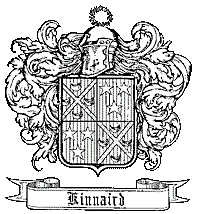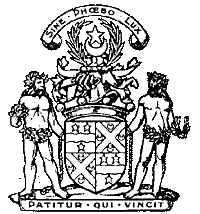
|
Kinnairds on the Net Clan Kinnaird Discussion Area Clan Kinnaird Contacts |

|
Kinnairds on the Net Clan Kinnaird Discussion Area Clan Kinnaird Contacts |

According to the Venerable Bede (circa 673 - 735) (a monk and famous historian from the Northumbrian Monastery at Jarrow), the Pictish race, one of the founding races of the British Isles, arrived in Scotland from Brittany about the 15th century BC From France the Picts had sailed northward to Ireland. The ancient Monarchies of Ireland refused them permission to land, but they were allowed to settle in the eastern part of Scotland, on condition that all their kings marry an Irish princess. This established a matriarchal hierarchy, first in the annals of British history. Some historians believe that the family name Kinnaird is descended from this source.
From some of the many early documents, researchers examined such records as the Inquisition, 1120 AD, the Black Book of the Exchequer, the Exchequer Rolls of Scotland, The Ragman Rolls, the Chronicles of the Picts and Scots and various other cartularies of parishes in Scotland. From these archives they produced the early records of the name in Perthshire, where they had been seated from very ancient times in the barony named Kinnaird.
The surname Kinnaird was found in many different forms and spellings. From time to time the surname was spelt Kinnard, Kynnard, Kennard, Kynharde, Kinzerd, Kinnart, Kynnart, Kynarde and some of these versions are still used today. These changes in spelling frequently occurred, even between father and son. Scribes and church people frequently selected their own version of what they thought the spelling should be.
The family name Kinnaird, emerged as a Scottish family in their original territories of Perthshire.
In 1180, Rudulphus Ruffus (a Flemish/Norman nobleman) received from his friend, King William the Lion (King of Scots), a Charter of land in the Carse of Gowrie. (Scots Peerage Vol.5, Antiquarian Notes and MacFarlane's Genealogy Collection Vol 1).
The area concerned is high and occupies a vantage point and may have been named in Gaelic as Ceann Ard, meaning high end or head. Other historians believe that from that time on, Rudulphus and his descendants took the name of Kinnaird as a surname.
 Another source indicates that Rudulphus name was in fact de Kynnaird.
Perhaps he actually gave his name to the area, which in turn, from the vocal sound,
became Ceann Ard in Gaelic.
Another source indicates that Rudulphus name was in fact de Kynnaird.
Perhaps he actually gave his name to the area, which in turn, from the vocal sound,
became Ceann Ard in Gaelic.
Rauf de Kynnard in Kincardine swore fealty to King Edward I of England in 1296. During the 13th century, the family name moved into the neighboring county of Fifeshire. William de Kynnarde was Burgess of Perth in 1428. Andrew de Kynharde was a charter witness in Dundee in 1435. Allan de Kynnarde granted a charter of the lands of Hill in 1449 and William Kynnard "of that ilk" is mentioned in 1546. Erche (Archie) Kinzerd was a tenant of the Abbey of Kelso in 1567 and by the 16th century there was record of the name in the border county of Roxburgh. The family of Kinnaird managed to Flourish during the middle ages, even though they made no alliances with the powerful clans and the senior branch of the family were made the Barons of Kinnaird.
Scotland during the 16th, 17th and 18th centuries, was ravaged by religious conflict. The newly found passionate fervor of Presbyterianism and the Church of Scotland rejected all who could not pass "The Test" of taking an oath of belief in the Church. Those failing 'The Test' were sometimes burnt at the stake or, more kindly, banished to Australia, the Carolinas or the West Indies.
Many were freely "encouraged" to migrate to Ireland. Families migrated from Scotland to Ireland with promises of cheap Irish land. They became known as the "Scotch/Irish". There is no record of distinguished family migration to Ireland, but this does not preclude the possibility of individual migration.
The migration or banishment to the New World also continued. Some went voluntarily from Ireland, but most went directly from Scotland.
In North America, some of the first migrates which could be considered kinsmen of the name Kinnaird, or having a variation of the family surname spelling were: William Kinnaird who settled in Charles Town SC in 1767 and William Kinnard who settled in Philadelphia P.A. in 1786.
From the original ports of entry the immigrants moved westward, some to the middle west, some across the prairies to the west coast. During the American War of Independence some remained loyal to the cause, whilst others became United Empire loyalists and moved north to Canada.
Many prominent people were a part of the Kinnaird name, notably Baron Kinnaird
of Inchture and Baron Kinnaird of Rossie. the Lord Kinnaird line expired a couple
of months ago, >when Lord Kinnaird (13th) died without any male heirs.
Information for this page was provided by the Clan Kinnaird Worldwide web site located at:http://www.kinnaird.net






